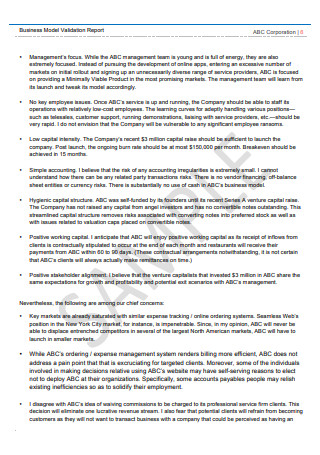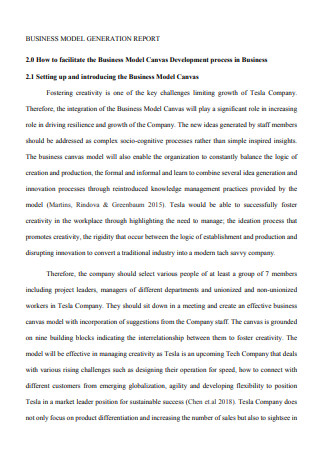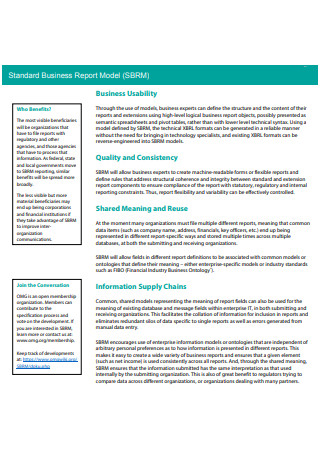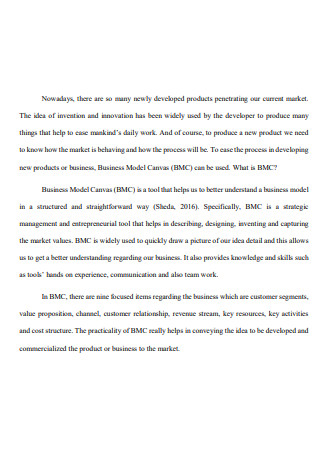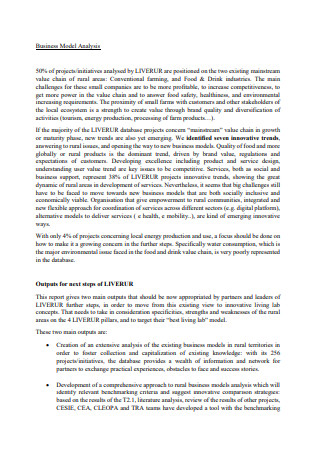4+ Sample Business Model Report
FREE Business Model Report s to Download
4+ Sample Business Model Report
What Is a Business Model Report?
Benefits of Business Model
Types of Business Models
Kinds of Business Reports
How to Establish the Right Business Model
FAQs
What is a business model example?
What elements should a business model contain?
What is a business report?
What Is a Business Model Report?
A business model report is critical for business investors. Consequently, additional information in the annual report has greater significance. The publication of a business model report may suggest that a company understands its business and key drivers, boosting investor confidence and reducing risk. Additionally, investors should comprehensively grasp the company, its prior performance, and the factors contributing to that accomplishment. Describe the business model to stakeholders if it facilitates their understanding of the company and interpretation of other data. Investors will always want to know how a company’s business model adapts to changing market conditions and how its overall strategy supports the model’s essential components. It is vital to report your business model for this reason. According to statistics, over 80% of businesses with employees survive their first year.
Benefits of Business Model
A business model outlines the precise processes, functions, and activities a corporation employs in the business environment to produce consumer goods and services. Typically, organizations develop a business model to assure the most efficient and effective production of goods and services. Business models can be advantageous if they are implemented and maintained effectively. Despite established industry models, business owners and managers may opt to create their own. The goal of the business model is to aid the organization in producing a business plan by establishing and validating the essential aspects of the business line, including activities, resources, customer relationships, income, and expenses. In addition, there are some advantages to establishing a business model, including:
Types of Business Models
Now that we’ve defined a business model in detail, let’s examine the various business models. As previously said, numerous business models can be adapted or altered depending on the unique firm or industry; establishing a disruptive business model is the common term for doing so. Although we will discuss five of the most frequent types of business models, there are different varieties that we will not discuss.
Kinds of Business Reports
Numerous ‘activities’ and ‘aspects’ of your everyday business are in constant flux, including sales trends and volume, marketing performance indicators, warehouse operational shifts, and inventory management alterations. These minor modifications to your business activities affect the worldwide health of your company, warehouse, restaurant, and even healthcare facility. Whether you operate a big or small firm, you must utilize business reports to set objectives, monitor activities, and assess the company’s overall health. Before developing business reports, it is essential to analyze the organization’s aims and objectives; this will allow you to select the appropriate report type for each case. Here are five basic visual business reports that can be utilized for various analytic reasons.
1. Analytical reports
Analytical reports are business reporting instruments that utilize qualitative and quantitative data to examine the execution of a business strategy or help when a company must make crucial decisions. Depending on the topic it needs to support, the data can be filtered and analyzed in several time frames, including daily, weekly, monthly, and quarterly. With this type of business report sample in hand, managers can rapidly determine if they are fulfilling their goals, identify areas for development, have a broader understanding of business sales performance, and discover practical ways to implement new tactics.
2. Research reports
Next in our discussion of business report kinds is the research report. Typically, businesses utilize these types of reports to assess the potential of a new product, investigate a new geographical area for sales, or determine how customers perceive their brand image. To develop this type of company report, managers frequently hire market research organizations to collect pertinent data about the topic under study. Often, research papers are presented as lengthy, static PowerPoint slides. With a modern market research dashboard such as this one, all data can be sorted based on specific requirements, and the entire presentation of results may be accomplished on a single screen. If you want to know the brand awareness of a particular location or age group, you can click on the graphs, and the entire dashboard will be filtered depending on this information. This makes the analytical process quick, engaging, and effective.
3. Industry reports
In continuation with the theme of research, the following sort of business report is an industry report. The performance and success of a firm can be measured effectively using benchmarks and objectives. However, these goals must be based on realistic values, given how crowded and competitive modern marketplaces are. Businesses can build intelligent strategies and establish attainable performance goals by obtaining a clear image of the typical industry figures, such as the competitive landscape, industry size, economic indicators, and trends.
4. Progress reports
Following are the progress updates. This type of business report, unlike our other examples, is not necessarily based on extensive research or advanced analytics but instead focuses on providing a clear picture of the success of a particular area or business objective. The visual form of these business reports makes them the ideal aid for meetings or business discussions, as they provide a quick overview of the condition of several KPIs. KPI scorecards are a famous use case for progress reports.
5. By business function
Modern business reports can provide a comprehensive view of a company’s operations. However, the actual value of these reports resides in the fact that they enable individual departments to utilize the power of data analysis in their decision-making. Your entire organization will be data-driven, whether it is the sales, human resources, or logistics departments.
How to Establish the Right Business Model
Most technical entrepreneurs focus intensely on developing a novel product but forget that a beautiful solution does not necessarily equate to a prosperous firm. Defining the optimal business model takes the same attentiveness as designing the optimal outcome, but the necessary methodology and talents are distinct. Investors recognize that two co-founders are frequently superior to one, focusing on the technical solution and the other on defining and constructing the business model. These two tasks must be completed simultaneously. This is known in the investing sector as proving the business model. It begins with validating a business opportunity, similar to how a proof of concept or prototype verifies a technological solution. Here are seven stages for developing an effective company model:
1. Confirm that your product or service solves the problem in the target segment
Existing approaches are frequently criticized for lacking intuitiveness and integration, although old solutions may be familiar and inflexible. As a minimum price, estimate your costs, including a 50 percent gross margin. Products priced too high for the market will fail, and products priced too low will leave you vulnerable. Match prices and market demographics of competitors. Also, once you have a prototype or alpha version, test it on real clients to determine if they experience the same thrill and joy that you do. Consider feedback on how to improve the fit. No business strategy can protect you if it does not alleviate the suffering or is ineffective.
2. Talk to industry professionals and investors about your channel and support plan
The time has come to present the entire company concept to a group of customers or a carefully chosen focus group. This must encompass all aspects of your price, marketing, distribution, and maintenance, in addition to the product itself. Here is another opportunity to make pivots for absolutely no expense. In addition, a small advisory board of outside experts in your field can provide you with objective comments and connections for establishing distribution and sales channels. Even if you are self-funding the endeavor, it is advantageous to solicit the opinions of possible investors.
3. Plan a trial or local deployment and collect consumer references
Positive traction on a limited rollout is an excellent confirmation of a business strategy. It enables you to evaluate expenses, quality, and pricing in a few outlets or a single city with minimal risk and rapid recovery. Save your viral marketing campaign and inventory expansion for later. In addition, pay special attention to your first few consumers and request testimonials and word-of-mouth support in exchange. If you cannot obtain their consent despite your efforts, the firm will likely not grow at the rate you anticipated.
4. Target national trade shows and industry association groups
As a final validation of your business strategy and product model in the context of big competitors, you require favorable exposure, credibility, and feedback from these firms. This may also be an excellent source of leads for the ultimate rollout and scale-up effort. Your business strategy may be a more durable competitive advantage than your product’s qualities, or it may represent your most significant risk exposure. Too many of the business plans I encounter are strong on competing product characteristics but scant on business model specifics and breakthroughs. If you or a team member have not spent at least as much time on the business model as on the product or service, you are only partially equipped for today’s business environment. It isn’t easy to win by performing only half the work, mainly if that half is the easier half.
FAQs
What is a business model example?
Standard business strategies include direct sales, franchising, advertising-based models, and brick-and-mortar stores. There are also hybrid models, such as enterprises that combine internet selling with physical stores and sporting organizations such as the NBA.
What elements should a business model contain?
The primary components of a business model should address your target clients, the market, the organization’s strengths and weaknesses, the product’s vital parts, and the sales strategy. This foundation lays the groundwork for your product roadmap’s following planning tool.
What is a business report?
A business report is a data that gives historical information regarding a company’s operations, production, and the insights of a particular department, as well as a foundation for future decision-making processes or the real insights required to structure corporate functions.
A successful report on your business model should answer crucial questions about your company, present a clear vision for it, and inform your stakeholders and investors about the strengths and limitations of your business model. So today, download our thorough Business Model Report! They are easily adaptable to get started.

